Paper Menu >>
Journal Menu >>
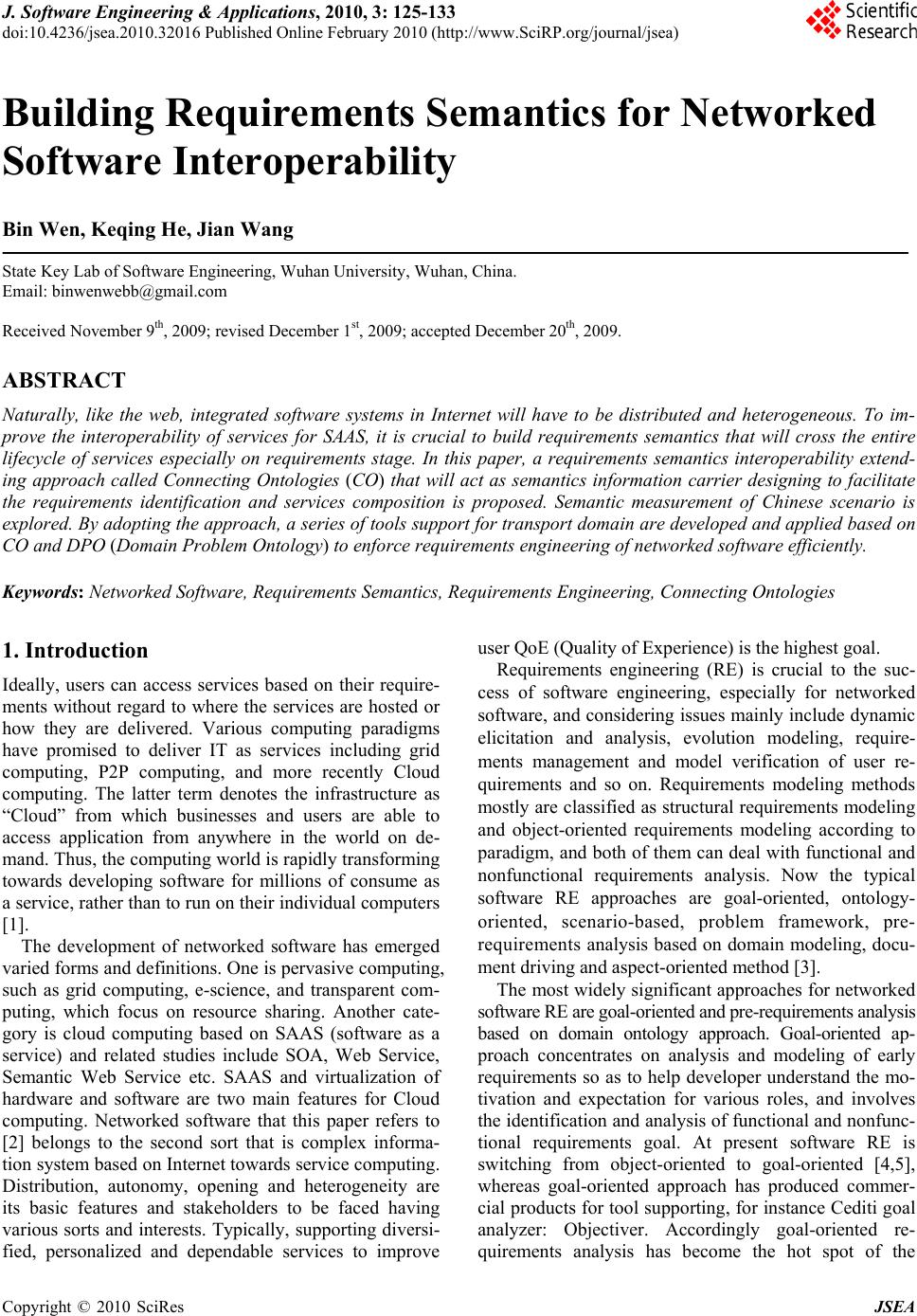 J. Software Engineering & Applications, 2010, 3: 125-133 doi:10.4236/jsea.2010.32016 Published Online February 2010 (http://www.SciRP.org/journal/jsea) Copyright © 2010 SciRes JSEA 125 Building Requirements Semantics for Networked Software Interoperability Bin Wen, Keqing He, Jian Wang State Key Lab of Software Engineering, Wuhan University, Wuhan, China. Email: binwenwebb@gmail.com Received November 9th, 2009; revised December 1st, 2009; accepted December 20th, 2009. ABSTRACT Naturally, like the web, integrated software systems in Internet will have to be distributed and heterogeneous. To im- prove the interoperability of services for SAAS, it is crucial to build requirements semantics that will cross the entire lifecycle of services especially on requirements stage. In this paper, a requirements semantics interoperability extend- ing approach called Connecting Ontologies (CO) that will act as semantics information carrier designing to facilitate the requirements identification and services composition is proposed. Semantic measurement of Chinese scenario is explored. By adopting the approach, a series of tools support for transport domain are developed and applied based on CO and DPO (Domain Proble m Ontology) to enforce requirements engineering of networked software efficiently. Keywords: Networked Software, Requirements Semantics, Requirements Engineering, Connecting Ontologies 1. Introduction Ideally, users can access services based on their require- ments without regard to where the services are hosted or how they are delivered. Various computing paradigms have promised to deliver IT as services including grid computing, P2P computing, and more recently Cloud computing. The latter term denotes the infrastructure as “Cloud” from which businesses and users are able to access application from anywhere in the world on de- mand. Thus, the computing world is rapidly transforming towards developing software for millions of consume as a service, rather than to run on their individual computers [1]. The development of networked software has emerged varied forms and definitions. One is pervasive computing, such as grid computing, e-science, and transparent com- puting, which focus on resource sharing. Another cate- gory is cloud computing based on SAAS (software as a service) and related studies include SOA, Web Service, Semantic Web Service etc. SAAS and virtualization of hardware and software are two main features for Cloud computing. Networked software that this paper refers to [2] belongs to the second sort that is complex informa- tion system based on Internet towards service computing. Distribution, autonomy, opening and heterogeneity are its basic features and stakeholders to be faced having various sorts and interests. Typically, supporting diversi- fied, personalized and dependable services to improve user QoE (Quality of Experience) is the highest goal. Requirements engineering (RE) is crucial to the suc- cess of software engineering, especially for networked software, and considering issues mainly include dynamic elicitation and analysis, evolution modeling, require- ments management and model verification of user re- quirements and so on. Requirements modeling methods mostly are classified as structural requirements modeling and object-oriented requirements modeling according to paradigm, and both of them can deal with functional and nonfunctional requirements analysis. Now the typical software RE approaches are goal-oriented, ontology- oriented, scenario-based, problem framework, pre- re qui re ment s analysis based on domain modeling, docu- ment driving and aspect-oriented method [3]. The most widely significant approaches for networked software RE are goal-oriented and pre-requirements analysis based on domain ontology approach. Goal-oriented ap- proach concentrates on analysis and modeling of early requirements so as to help developer understand the mo- tivation and expectation for various roles, and involves the identification and analysis of functional an d nonfunc- tional requirements goal. At present software RE is switching from object-oriented to goal-oriented [4,5], whereas goal-oriented approach has produced commer- cial products for tool su pporting, for instance Cediti goal analyzer: Objectiver. Accordingly goal-oriented re- quirements analysis has become the hot spot of the 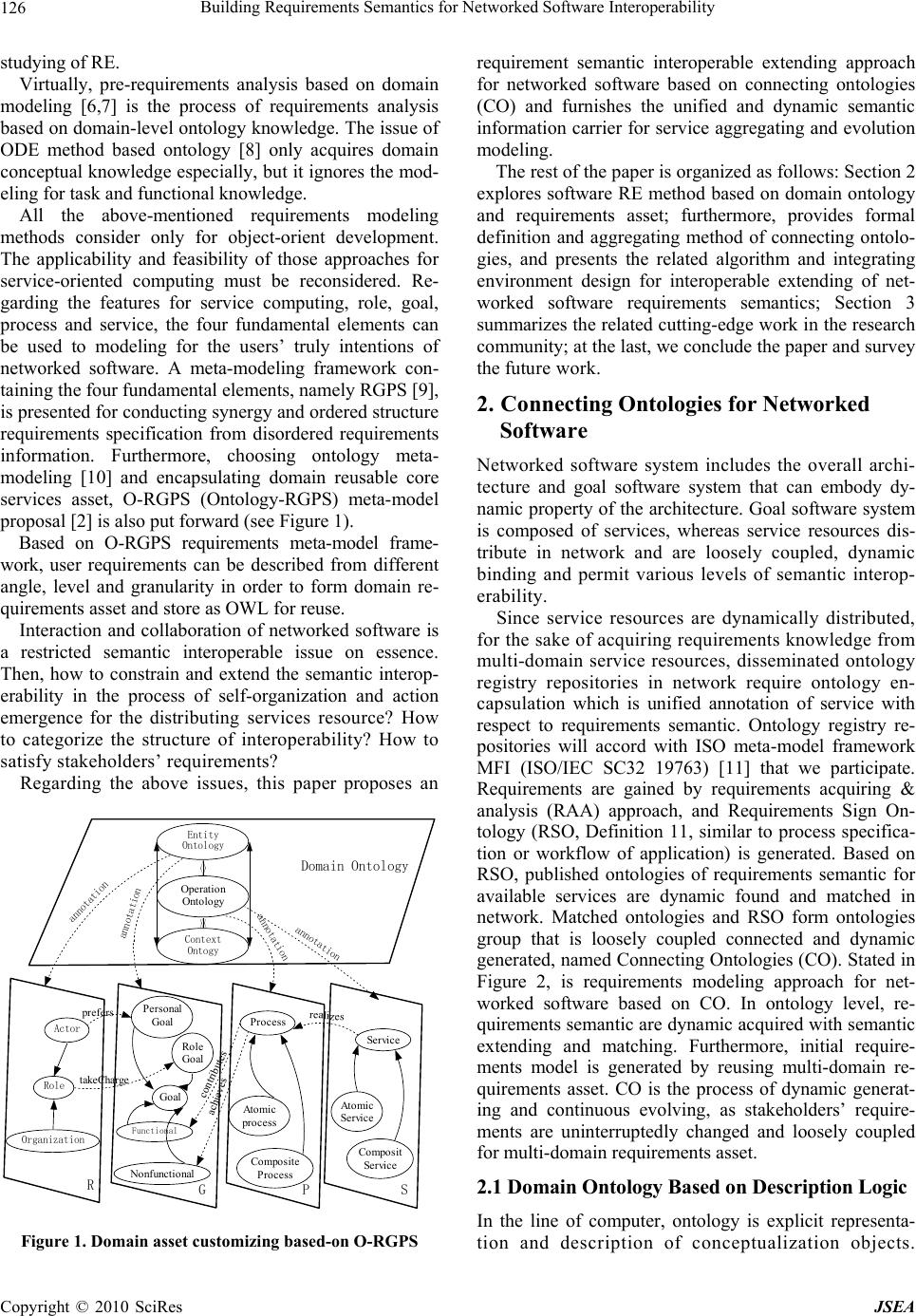 Building Requirements Semantics for Networked Software Inter o perability 126 studying of RE . Virtually, pre-requirements analysis based on domain modeling [6,7] is the process of requirements analysis based on domain-level ontology knowledge. The issue of ODE method based ontology [8] only acquires domain conceptual knowledge especially, but it ignores the mod- eling for task and functio nal knowledge. All the above-mentioned requirements modeling methods consider only for object-orient development. The applicability and feasibility of those approaches for service-oriented computing must be reconsidered. Re- garding the features for service computing, role, goal, process and service, the four fundamental elements can be used to modeling for the users’ truly intentions of networked software. A meta-modeling framework con- taining the four fundamental elements, namely RGPS [9], is presented for condu cting syn ergy and order ed structur e requirements specification from disordered requirements information. Furthermore, choosing ontology meta- modeling [10] and encapsulating domain reusable core services asset, O-RGPS (Ontology-RGPS) meta-model proposal [2] is al so put fo rward (see Figure 1). Based on O-RGPS requirements meta-model frame- work, user requirements can be described from different angle, level and granularity in order to form domain re- quirements asset and store as OWL for reuse. Interaction and collaboration of networked software is a restricted semantic interoperable issue on essence. Then, how to constrain and extend the semantic interop- erability in the process of self-organization and action emergence for the distributing services resource? How to categorize the structure of interoperability? How to satisfy stakeholders’ requirements? Regarding the above issues, this paper proposes an Entity Ontology Operation Onto logy Context Ontogy Actor Role Organization Domain Ontology R Personal Goal Ro le Goal Go al Functional Nonfunctional prefers t akeCharge Process Atom ic process Co m posit e Process contributes achieves Service Atomic Se rvice Co mposit Service realizes annotation annotation annotation annotation PGS Figure 1. Domain asset customizing based-on O-RGPS requirement semantic interoperable extending approach for networked software based on connecting ontologies (CO) and furnishes the unified and dynamic semantic information carrier for service aggregating and evolution modeling. The rest of the paper is organized as follows: Section 2 explores software RE method based on domain ontology and requirements asset; furthermore, provides formal definition and aggregating method of connecting ontolo- gies, and presents the related algorithm and integrating environment design for interoperable extending of net- worked software requirements semantics; Section 3 summarizes the related cutting-edge work in the research community; at the last, we conclude the paper an d survey the future work. 2. Connecting Ontologies for Networked Software Networked software system includes the overall archi- tecture and goal software system that can embody dy- namic property of the architecture. Goal software system is composed of services, whereas service resources dis- tribute in network and are loosely coupled, dynamic binding and permit various levels of semantic interop- erability. Since service resources are dynamically distributed, for the sake of acquiring requirements knowledge from multi-domain service resources, disseminated ontology registry repositories in network require ontology en- capsulation which is unified annotation of service with respect to requirements semantic. Ontology registry re- positories will accord with ISO meta-model framework MFI (ISO/IEC SC32 19763) [11] that we participate. Requirements are gained by requirements acquiring & analysis (RAA) approach, and Requirements Sign On- tology (RSO, Definition 11, similar to process specifica- tion or workflow of application) is generated. Based on RSO, published ontologies of requirements semantic for available services are dynamic found and matched in network. Matched ontologies and RSO form ontologies group that is loosely coupled connected and dynamic generated, named Connecting Ontologies (CO). Stated in Figure 2, is requirements modeling approach for net- worked software based on CO. In ontology level, re- quirements semantic are dynamic acquired with semantic extending and matching. Furthermore, initial require- ments model is generated by reusing multi-domain re- quirements asset. CO is the process of dynamic generat- ing and continuous evolving, as stakeholders’ require- ments are uninterruptedly changed and loosely coupled for multi-domain requirements asset. 2.1 Domain Ontology Based on Description Logic In the line of computer, ontology is explicit representa- tion and description of conceptualization objects. Copyright © 2010 SciRes JSEA 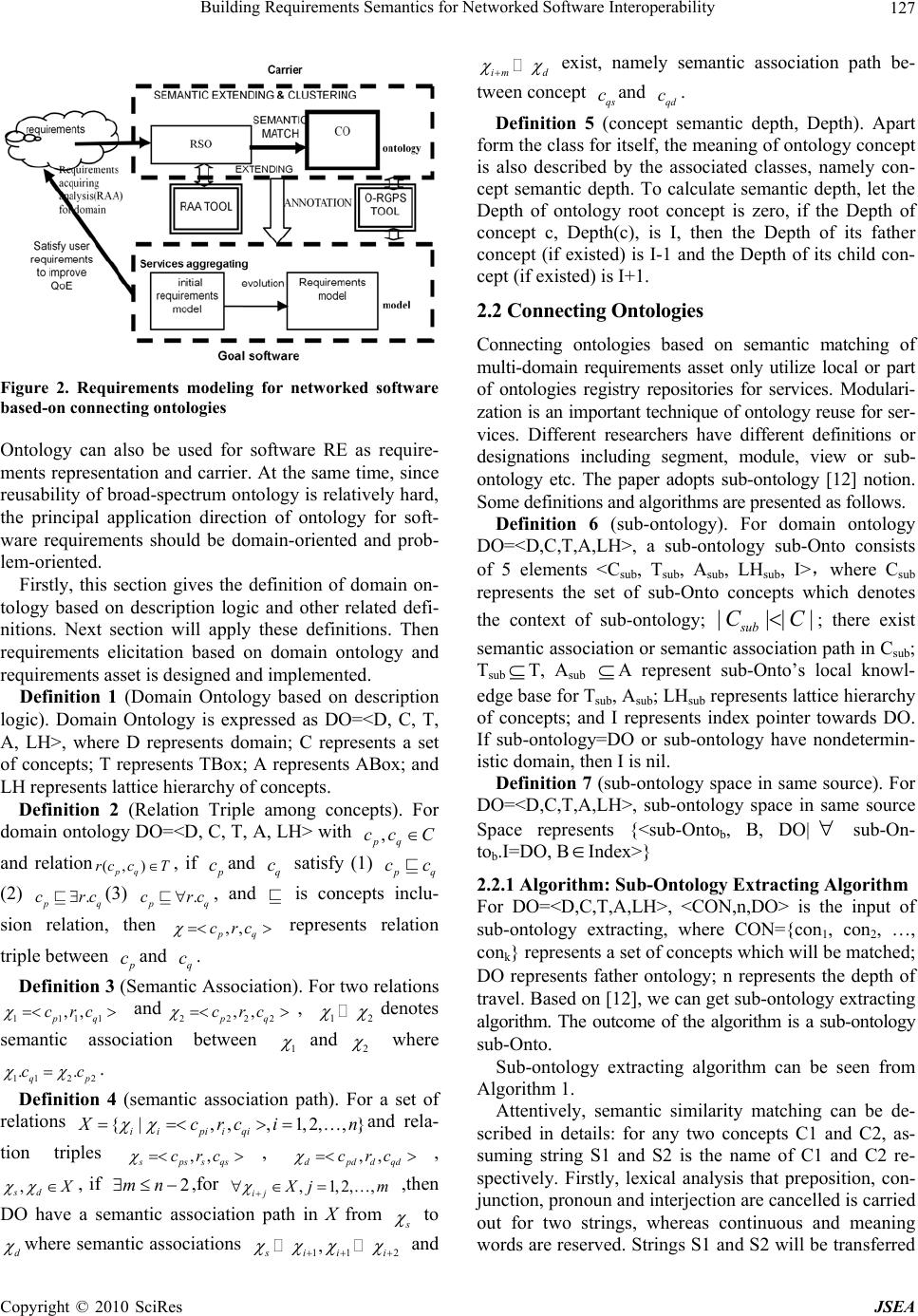 Building Requirements Semantics for Networked Software Inter o perability127 Figure 2. Requirements modeling for networked software based-on connecting ontologies Ontology can also be used for software RE as require- ments representation and carrier. At the same time, since reusability of broad-spectru m ontology is relatively hard , the principal application direction of ontology for soft- ware requirements should be domain-oriented and prob- lem-oriented. Firstly, this section gives the definition of domain on- tology based on description logic and other related defi- nitions. Next section will apply these definitions. Then requirements elicitation based on domain ontology and requirements asset is designed and implemented. Definition 1 (Domain Ontology based on description logic). Domain Ontology is expressed as DO=<D, C, T, A, LH>, where D represents domain; C represents a set of concepts; T represents TBox; A represents ABox; and LH represents lattice hierarchy of concepts. Definition 2 (Relation Triple among concepts). For domain ontology DO=<D, C, T, A, LH> with , pq cc C and relation, if (,) pq rc cT p cand satisfy (1) q c p q cc (2) . p q rcc(3) . p q rc cr c , and is concepts inclu- sion relation, then represents relation triple between ,, p c q p cand . q c Definition 3 (Semantic Association). For two relations and, 1111 ,, pq crc 2222 ,, pq crc 12 denotes semantic association between 1 and 2 where . 1122 .. qp cc Definition 4 (semantic association path). For a set of relations {|,,, 1,2,,} ii piiqi Xcrcin ,, spssqs crc dp cr and rela- tion triples , , ,, ddqd c , sdX , if ,for ,then DO have a semantic association path in X from 2mn,1,2, ij Xj ,m s to d where semantic associations 11 ,2 s ii i and im d exist, namely semantic association path be- tween concept and . qs c qd c Definition 5 (concept semantic depth, Depth). Apart form the class for itself, the meaning of ontology con cept is also described by the associated classes, namely con- cept semantic depth. To calculate semantic depth, let the Depth of ontology root concept is zero, if the Depth of concept c, Depth(c), is I, then the Depth of its father concept (if existed) is I-1 and the Depth of its child con- cept (if existed) is I+1. 2.2 Connecting Ontologies Connecting ontologies based on semantic matching of multi-domain requirements asset only utilize local or part of ontologies registry repositories for services. Modulari- zation is an important technique of ontology reuse for ser- vices. Different researchers have different definitions or designations including segment, module, view or sub- ontology etc. The paper adopts sub-ontology [12] notion. Some definitions and algorithms are presented as follows. Definition 6 (sub-ontology). For domain ontology DO=<D,C,T,A,LH>, a sub-ontology sub-Onto consists of 5 elements <Csub, Tsub, Asub, LHsub, I>,where Csub represents the set of sub-Onto concepts which denotes the context of sub-ontology; ; there exist semantic association or semantic association path in Csub; Tsub T, Asub A represent sub-Onto’s local knowl- edge base for Tsub, Asub; LHsub represents lattice hierarchy of concepts; and I represents index pointer towards DO. If sub-ontology=DO or sub-ontology have nondetermin- istic domain, then I is nil. ||| sub CC| Definition 7 (sub-ontology space in same source). For DO=<D,C,T,A,LH>, sub-ontology space in same source Space represents {<sub-Ontob, B, DO| sub-On- tob.I=DO, B Index>} 2.2.1 Algorithm: Sub-Ontology Extracting Algorithm For DO=<D,C,T,A,LH>, <CON,n,DO> is the input of sub-ontology extracting, where CON={con1, con2, …, conk} represents a set of concepts which will be matched; DO represents father ontology; n represents the depth of travel. Based on [12], we can get sub-ontology extracting algorithm. The outcome of the algorithm is a sub-ontology sub-Onto. Sub-ontology extracting algorithm can be seen from Algorithm 1. Attentively, semantic similarity matching can be de- scribed in details: for any two concepts C1 and C2, as- suming string S1 and S2 is the name of C1 and C2 re- spectively. Firstly, lexical analysis that preposition, con- junction, pronoun and interjection are cancelled is carried out for two strings, whereas continuous and meaning words are reserved. Strings S1 and S2 will be transferred Copyright © 2010 SciRes JSEA 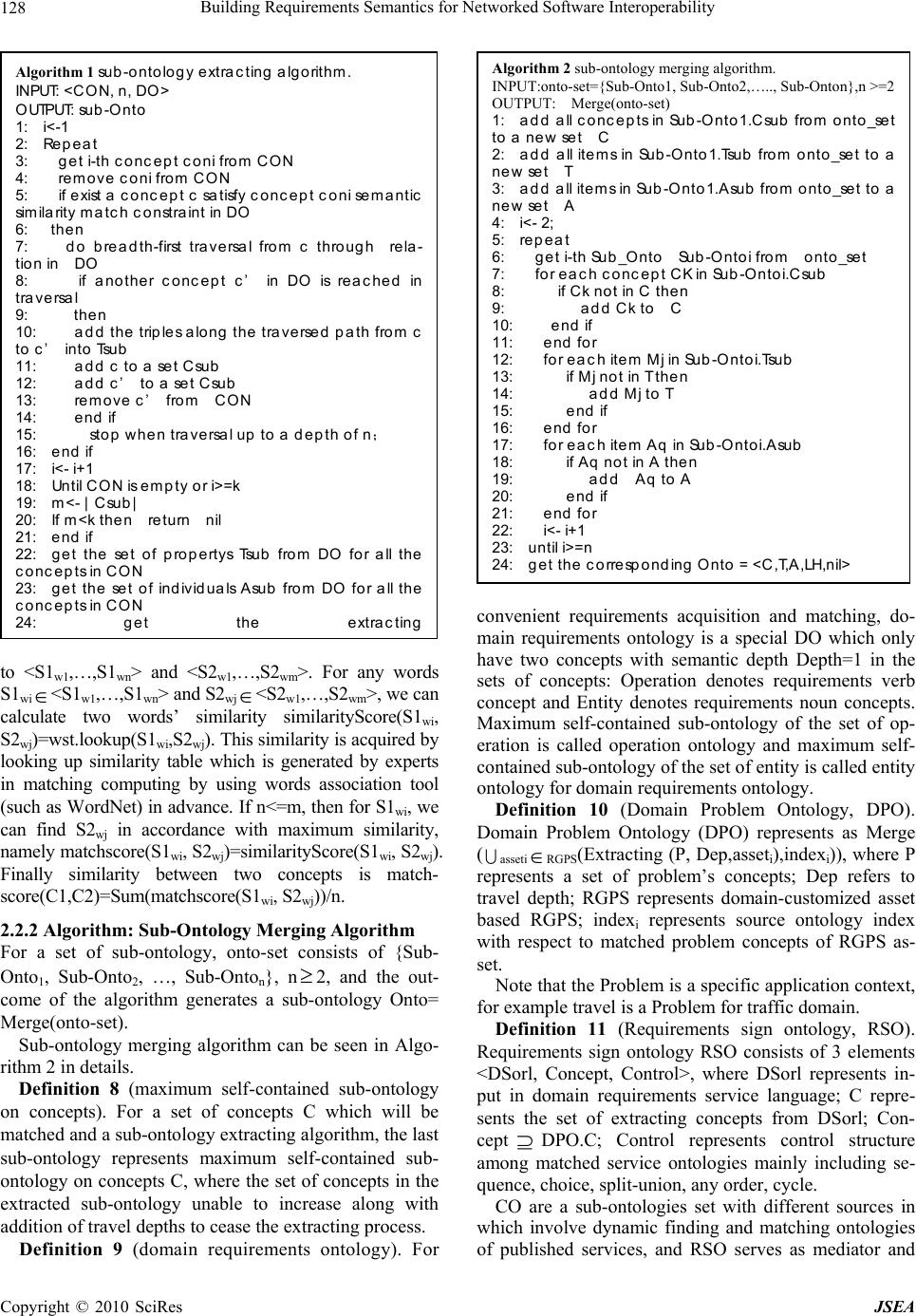 Building Requirements Semantics for Networked Software Inter o perability 128 to <S1w1,…,S1wn> and <S2w1 ,…,S2wm>. For any words S1wi<S1w1,…,S1wn> and S2wj <S2w1,…,S2wm>, we can calculate two words’ similarity similarityScore(S1wi, S2wj)=wst.lookup(S1wi,S2wj). This similarity is acquired by looking up similarity table which is generated by experts in matching computing by using words association tool (such as WordNet) in advance. If n<=m, then for S1wi, we can find S2wj in accordance with maximum similarity, namely matchscore(S1wi, S2wj)=similarityScore(S1wi, S2wj). Finally similarity between two concepts is match- score(C1,C2)=Sum(matchscore(S1wi, S2wj))/n. 2.2.2 Algorithm: Sub-Ontology Merging Algorithm For a set of sub-ontology, onto-set consists of {Sub- Onto1, Sub-Onto2, …, Sub-Onton}, n2, and the out- come of the algorithm generates a sub-ontology Onto= Merge(onto-set). Sub-ontology merging algorithm can be seen in Algo- rithm 2 in details. Definition 8 (maximum self-contained sub-ontology on concepts). For a set of concepts C which will be matched and a sub-on tology ex tracting algorithm, the last sub-ontology represents maximum self-contained sub- ontology on concepts C, where the set of concepts in the extracted sub-ontology unable to increase along with addition of travel depths to cease th e extracting process. Definition 9 (domain requirements ontology). For Algorithm 2 sub-on tolo gy merging algorithm. INPUT:onto-set={Sub-Onto1, Sub-Onto2,….., Sub-Onton},n >=2 OUTPUT: Merge(onto-set) 1: add all concepts in Sub-Onto1.Csub from onto_set to a new set C 2: add all items in Sub-Onto1.Tsub from onto_set to a new set T 3: add all items in Sub-Onto1.Asub from onto_set to a new set A 4: i<- 2; 5: repeat 6: get i-th Sub_Onto Sub-Ontoi from onto_set 7: for each concept CK in Sub-Ontoi.Csub 8: if Ck not in C then 9: add Ck to C 10: end if 11: end for 12: for each item Mj in Sub-Ontoi.Tsub 13: if Mj not in T then 14: add Mj to T 15: end if 16: end for 17: for each item Aq in Sub-Ontoi.Asub 18: if Aq not in A then 19: add Aq to A 20: end if 21: end for 22: i<- i+1 23: until i>=n 24: get the corresponding Onto = <C,T,A,LH,nil> Algorithm 1 sub-ontology extracting algor ithm. INPUT: <CON, n, DO> OUTPUT: sub-Onto 1: i<-1 2: Repeat 3: get i-th concept coni from CON 4: remove coni from CON 5: if exist a concept c satisfy concept coni semantic similarity match constraint in DO 6: then 7: do breadth-first traversal from c through rela- tion in DO 8: if another concept c’ in DO is reached in traversal 9: then 10: ad d the tripl es alon g the tr av ersed path from c to c’ into Tsub 11: add c to a set Csub 12: add c’ to a set Csub 13: remove c’ from CON 14: end if 15: stop when traversal up to a depth of n; 16: end if 17: i<- i+1 18: Until CON is empty or i>=k 19: m<- |Csub| 20: If m<k then return nil 21: end if 22: get the set of propertys Tsub from DO for all the concepts in CON 23: get the set of individuals Asub from DO for all the concepts in CON 24: g et the extractin g convenient requirements acquisition and matching, do- main requirements ontology is a special DO which only have two concepts with semantic depth Depth=1 in the sets of concepts: Operation denotes requirements verb concept and Entity denotes requirements noun concepts. Maximum self-contained sub-ontology of the set of op- eration is called operation ontology and maximum self- contained sub-o ntolog y of the set o f entity is called en tity ontology for domain requirements ontology. Definition 10 (Domain Problem Ontology, DPO). Domain Problem Ontology (DPO) represents as Merge (asseti RGPS(Extracting (P, Dep,asseti),indexi)), where P represents a set of problem’s concepts; Dep refers to travel depth; RGPS represents domain-customized asset based RGPS; indexi represents source ontology index with respect to matched problem concepts of RGPS as- set. Note that the Problem is a specific application context, for example travel is a Problem for traffic domain. Definition 11 (Requirements sign ontology, RSO). Requirements sign ontology RSO consists of 3 elements <DSorl, Concept, Control>, where DSorl represents in- put in domain requirements service language; C repre- sents the set of extracting concepts from DSorl; Con- cept DPO.C; Control represents control structure among matched service ontologies mainly including se- quence, choice, split-union, any order, cycle. CO are a sub-ontologies set with different sources in which involve dynamic finding and matching ontologies of published services, and RSO serves as mediator and Copyright © 2010 SciRes JSEA 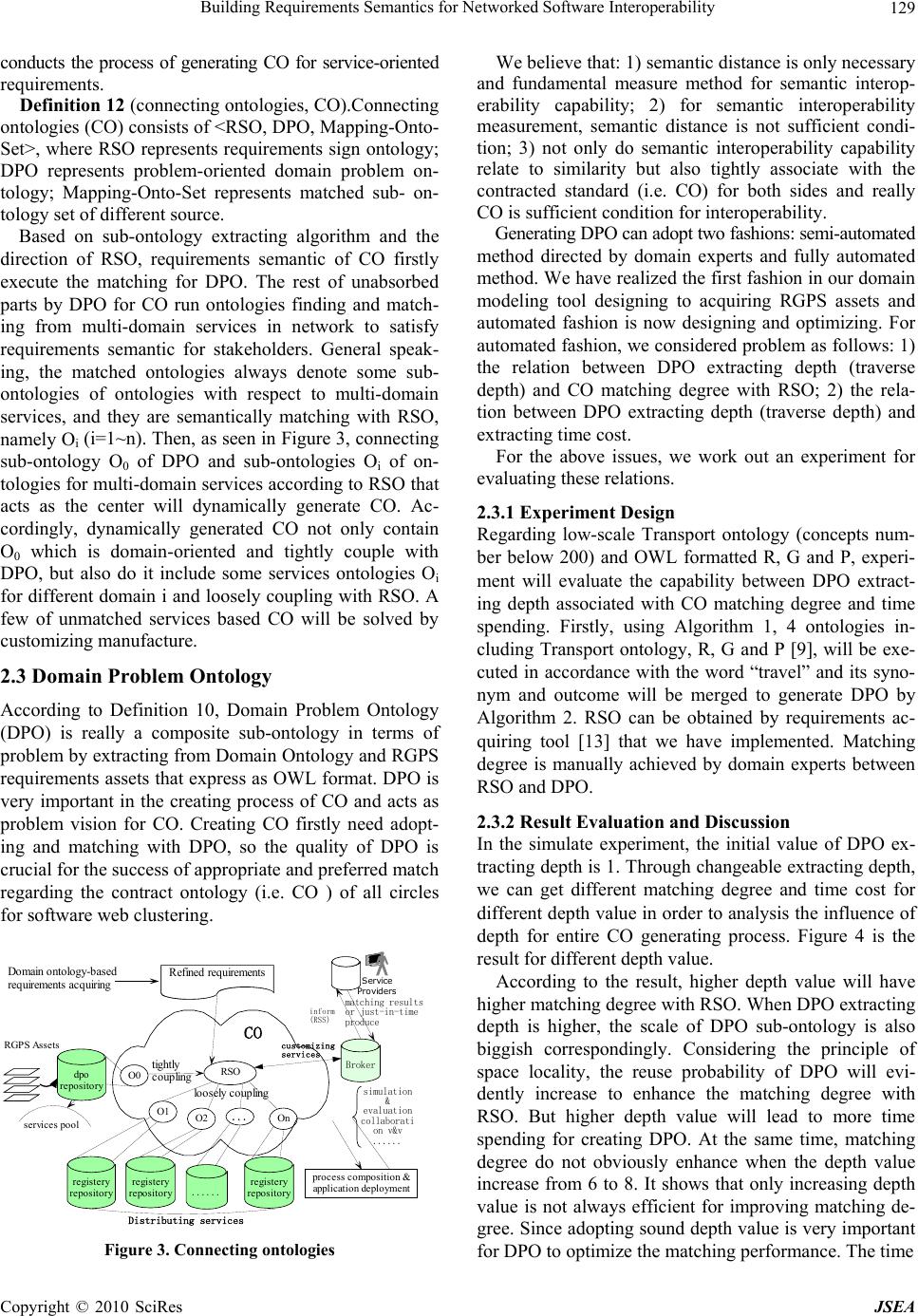 Building Requirements Semantics for Networked Software Inter o perability129 conducts the process of generating CO for service-oriented requirements. Definition 12 (connecting ontologies, CO).Connecting ontologies (CO) consists of <RSO, DPO, Mapping-Onto- Set>, where RSO represents requirements sign ontology; DPO represents problem-oriented domain problem on- tology; Mapping-Onto-Set represents matched sub- on- tology set of different source . Based on sub-ontology extracting algorithm and the direction of RSO, requirements semantic of CO firstly execute the matching for DPO. The rest of unabsorbed parts by DPO for CO run ontologies finding and match- ing from multi-domain services in network to satisfy requirements semantic for stakeholders. General speak- ing, the matched ontologies always denote some sub- ontologies of ontologies with respect to multi-domain services, and they are semantically matching with RSO, namely Oi (i=1~n). Then, as seen in Figure 3, connecting sub-ontology O0 of DPO and sub-ontologies Oi of on- tologies for multi-domain services according to RSO that acts as the center will dynamically generate CO. Ac- cordingly, dynamically generated CO not only contain O0 which is domain-oriented and tightly couple with DPO, but also do it include some services ontologies Oi for different domain i and loosely couplin g with RSO. A few of unmatched services based CO will be solved by customizing manufacture. 2.3 Domain Problem Ontology According to Definition 10, Domain Problem Ontology (DPO) is really a composite sub-ontology in terms of problem by extracting from Domain Ontology and RGPS requirements assets that express as OWL format. DPO is very important in the creating process of CO and acts as problem vision for CO. Creating CO firstly need adopt- ing and matching with DPO, so the quality of DPO is crucial for the success of appropriate and preferred match regarding the contract ontology (i.e. CO ) of all circles for software web clustering. dpo repository Broker R GPS Assets services p ool R efined requirements RSO Service Provid e rs inform (RSS) matching results or just-in-time produce process compositi on & application deployment simulation & evaluation collaborati on v&v ...... registery repository O1 O2 ... On registery repository ...... registery repository O0 tightly coupling lo osely c oupling Distributing services Dom ain ontology-based requirements acquiring CO customizing services Figure 3. Connecting ontologies We believe that: 1) semantic distance is only necessary and fundamental measure method for semantic interop- erability capability; 2) for semantic interoperability measurement, semantic distance is not sufficient condi- tion; 3) not only do semantic interoperability capability relate to similarity but also tightly associate with the contracted standard (i.e. CO) for both sides and really CO is sufficient condition for interoperability. Generating DPO can adopt two fashions: semi-automated method directed by domain experts and fully automated method. We have realized the first fashion in our domain modeling tool designing to acquiring RGPS assets and automated fashion is now designing and optimizing. For automated fashion, we considered problem as follo ws: 1) the relation between DPO extracting depth (traverse depth) and CO matching degree with RSO; 2) the rela- tion between DPO extracting depth (traverse depth) and extracting time cost. For the above issues, we work out an experiment for evaluating these relations. 2.3.1 Experiment Design Regarding low-scale Transport ontology (concepts num- ber below 200) and OWL formatted R, G and P, experi- ment will evaluate the capability between DPO extract- ing depth associated with CO matching degree and time spending. Firstly, using Algorithm 1, 4 ontologies in- cluding Transport ontology, R, G and P [9], will be exe- cuted in accordance with the word “travel” and its syno- nym and outcome will be merged to generate DPO by Algorithm 2. RSO can be obtained by requirements ac- quiring tool [13] that we have implemented. Matching degree is manually achieved by domain experts between RSO and DPO. 2.3.2 Result Evaluation and Discussion In the simulate experiment, the initial value of DPO ex- tracting depth is 1. Through changeable extracting depth, we can get different matching degree and time cost for different depth value in order to analysis the influence of depth for entire CO generating process. Figure 4 is the result for diffe rent depth val ue. According to the result, higher depth value will have higher matching degree with RSO. When DPO extracting depth is higher, the scale of DPO sub-ontology is also biggish correspondingly. Considering the principle of space locality, the reuse probability of DPO will evi- dently increase to enhance the matching degree with RSO. But higher depth value will lead to more time spending for creating DPO. At the same time, matching degree do not obviously enhance when the depth value increase from 6 to 8. It shows that only increasing depth value is not always efficient for improving matching de- gree. Since adopting sound depth value is very important for DPO to optimize the matching performance. The time Copyright © 2010 SciRes JSEA 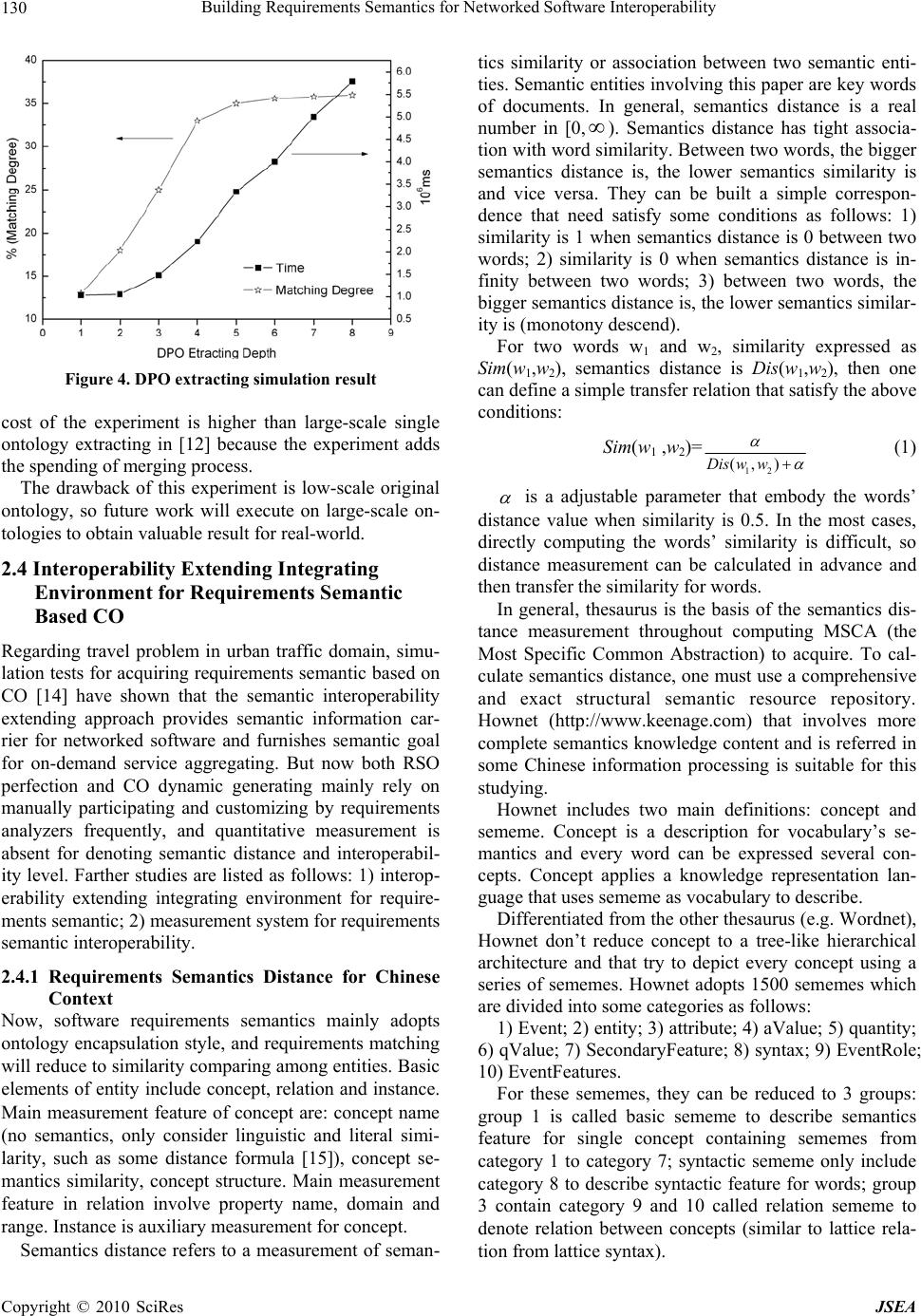 Building Requirements Semantics for Networked Software Inter o perability 130 Figure 4. DPO extracting simulation result cost of the experiment is higher than large-scale single ontology extracting in [12] because the experiment adds the spending of merging process. The drawback of this experiment is low-scale original ontology, so future work will execute on large-scale on- tologies to obtain valuable result for real-wor ld. 2.4 Interoperability Extending Integrating Environment for Requirements Semantic Based CO Regarding travel problem in urban traffic domain, simu- lation tests for acquiring requirements semantic b ased on CO [14] have shown that the semantic interoperability extending approach provides semantic information car- rier for networked software and furnishes semantic goal for on-demand service aggregating. But now both RSO perfection and CO dynamic generating mainly rely on manually participating and customizing by requirements analyzers frequently, and quantitative measurement is absent for denoting semantic distance and interoperabil- ity level. Farther studies are listed as follows: 1) interop- erability extending integrating environment for require- ments semantic; 2) measurement system for requirements semantic interoperability. 2.4.1 Requirements Semantics Distance for Chinese Context Now, software requirements semantics mainly adopts ontology encapsulation style, and requirements matching will reduce to similarity comparing among entities. Basic elements of entity inclu de concept, relation and instance. Main measurement feature of concept are: concept name (no semantics, only consider linguistic and literal simi- larity, such as some distance formula [15]), concept se- mantics similarity, concept structure. Main measurement feature in relation involve property name, domain and range. Instance is auxiliary measurement for con cept. Semantics distance refers to a measurement of seman- tics similarity or association between two semantic enti- ties. Semantic entities involving th is paper are key words of documents. In general, semantics distance is a real number in [0, ). Semantics distance has tight associa- tion with word similarity. Between two words, the bigger semantics distance is, the lower semantics similarity is and vice versa. They can be built a simple correspon- dence that need satisfy some conditions as follows: 1) similarity is 1 when semantics distance is 0 between two words; 2) similarity is 0 when semantics distance is in- finity between two words; 3) between two words, the bigger semantics distance is, the lower semantics similar- ity is (monotony descend). For two words w1 and w2, similarity expressed as Sim(w1,w2), semantics distance is Dis(w1,w2), then one can define a simple transfer relation that satisfy the above conditions: Sim(w1 ,w2)= 12 (, )Dis ww (1) is a adjustable parameter that embody the words’ distance value when similarity is 0.5. In the most cases, directly computing the words’ similarity is difficult, so distance measurement can be calculated in advance and then transfer the similarity for words. In general, thesaurus is the basis of the semantics dis- tance measurement throughout computing MSCA (the Most Specific Common Abstraction) to acquire. To cal- culate semantics distance, one must use a comprehensive and exact structural semantic resource repository. Hownet (http://www.keenage.com) that involves more complete semantics knowledge conten t and is referred in some Chinese information processing is suitable for this studying. Hownet includes two main definitions: concept and sememe. Concept is a description for vocabulary’s se- mantics and every word can be expressed several con- cepts. Concept applies a knowledge representation lan- guage that uses sememe as vocabulary to describe. Differentiated from the other thesaurus (e.g. Wordnet), Hownet don’t reduce concept to a tree-like hierarchical architecture and that try to depict every concept using a series of sememes. Hownet adopts 1500 sememes which are divided into some categories as follows: 1) Event; 2 ) entity; 3) attribu te; 4) aValue; 5) quantity; 6) qValue; 7) SecondaryFeature; 8) syntax; 9) EventRole; 10) EventFeatures. For these sememes, they can be reduced to 3 groups: group 1 is called basic sememe to describe semantics feature for single concept containing sememes from category 1 to category 7; syntactic sememe only include category 8 to describe syntactic feature for words; group 3 contain category 9 and 10 called relation sememe to denote relation between concepts (similar to lattice rela- tion from lattice syntax). Copyright © 2010 SciRes JSEA 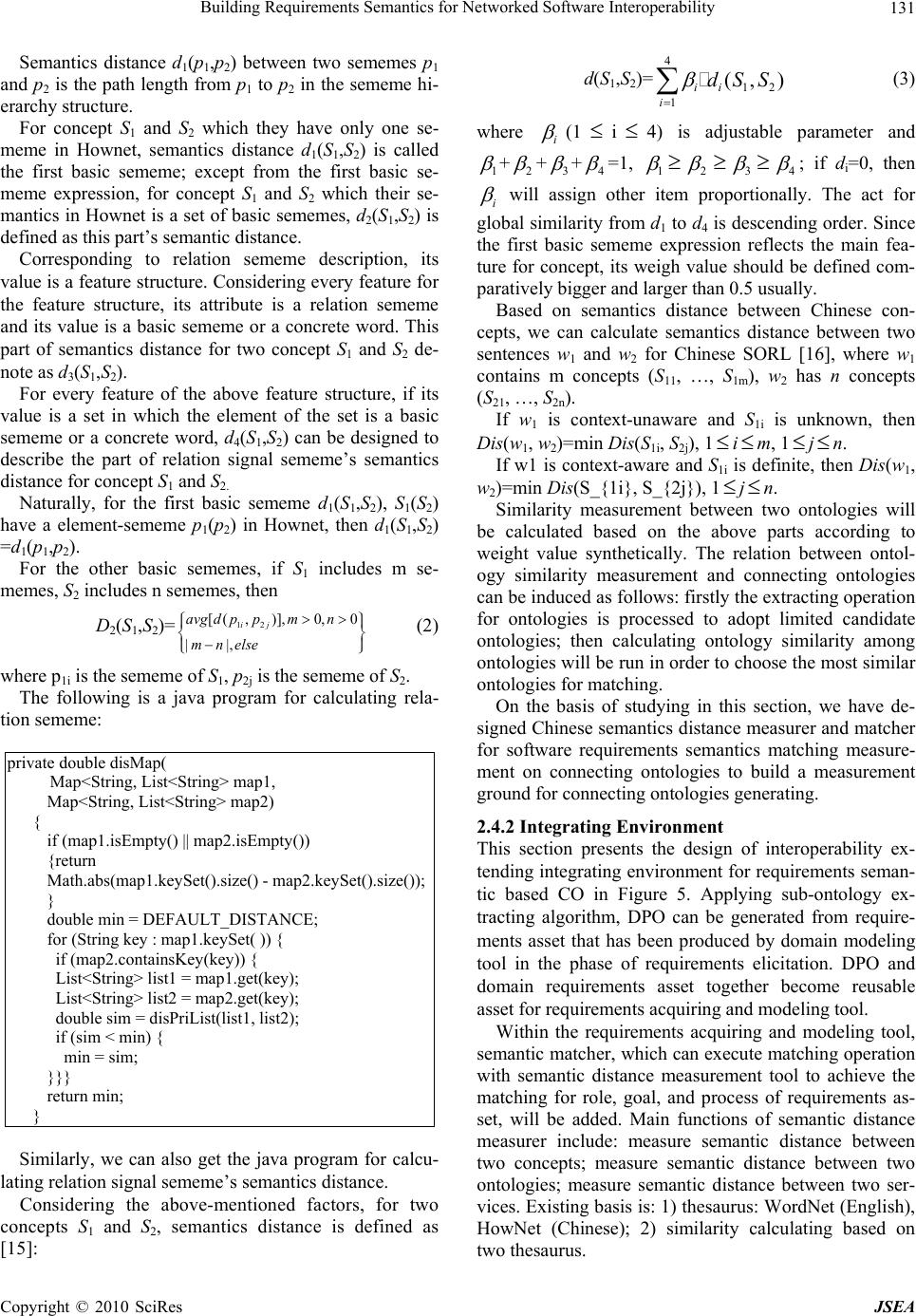 Building Requirements Semantics for Networked Software Inter o perability131 Semantics distance d1(p1,p2) between two sememes p1 and p2 is the path length from p1 to p2 in the s ememe hi- erarchy structure. For concept S1 and S2 which they have only one se- meme in Hownet, semantics distance d1(S1,S2) is called the first basic sememe; except from the first basic se- meme expression, for concept S1 and S2 which their se- mantics in Hownet is a set of basic sememes, d2(S1,S2) is defined as this part’s semantic distance. Corresponding to relation sememe description, its value is a feature structure. Considering every feature for the feature structure, its attribute is a relation sememe and its value is a basic sememe or a concrete word. This part of semantics distance for two concept S1 and S2 de- note as d3(S1,S2). For every feature of the above feature structure, if its value is a set in which the element of the set is a basic sememe or a concrete word, d4(S1,S2) can be designed to describe the part of relation signal sememe’s semantics distance for co nce pt S1 and S2. Naturally, for the first basic sememe d1(S1,S2), S1(S2) have a element-sememe p1(p2) in Hownet, then d1(S1,S2) =d1(p1,p2). For the other basic sememes, if S1 includes m se- memes, S2 includes n sememes, then D2(S1,S2)= (2) 12 [( ,)],0,0 ||, ij avg dppmn mnelse where p1i is the sememe of S1, p2j is the sememe of S2. The following is a java program for calculating rela- tion sememe: private double disMap( Map<String, List<String> map1, Map<String, List<String> map2) { if (map1.isEmpty() || map2.isEmpty()) {return Math.abs(map1.keySet().size() - map2.keySet().size()); } double min = DEFAULT_DISTANCE; for (String key : map1.keySet( )) { if (map2.containsKey(key)) { List<String> list1 = map1.get(key); List<String> list2 = map2.get(key); double sim = disPriList(list1, list2); if (sim < min) { min = sim; }}} return min; } Similarly, we can also get the java program for calcu- lating relation signal sememe’s semantics distance. Considering the above-mentioned factors, for two concepts S1 and S2, semantics distance is defined as [15]: d(S1,S2)= (3) 4 12 1 (, ) ii i dSS where i (1 i 4) is adjustable parameter and 1 +2 +3 +4 =1, 1 2 3 4 ; if di=0, then i will assign other item proportionally. The act for global similarity from d1 to d4 is descending order. Since the first basic sememe expression reflects the main fea- ture for concept, its weigh value should be defined com- paratively bigger and larger than 0.5 usually. Based on semantics distance between Chinese con- cepts, we can calculate semantics distance between two sentences w1 and w2 for Chinese SORL [16], where w1 contains m concepts (S11, …, S1m), w2 has n concepts (S21, …, S2n). If w1 is context-unaware and S1i is unknown, then Dis(w1, w2)=min Dis(S1i, S2j), 1im, 1jn. If w1 is context-aware and S1i is definite, then Dis(w1, w2)=min Dis(S_{1i}, S_{2j}), 1jn. Similarity measurement between two ontologies will be calculated based on the above parts according to weight value synthetically. The relation between ontol- ogy similarity measurement and connecting ontologies can be induced as follows: firstly the extracting operation for ontologies is processed to adopt limited candidate ontologies; then calculating ontology similarity among ontologies will be run in order to choose th e most similar ontologies for matching. On the basis of studying in this section, we have de- signed Chinese semantics distance measurer and matcher for software requirements semantics matching measure- ment on connecting ontologies to build a measurement ground for connecting ontologies generating. 2.4.2 Integrating Environment This section presents the design of interoperability ex- tending integrating environment for requirements seman- tic based CO in Figure 5. Applying sub-ontology ex- tracting algorithm, DPO can be generated from require- ments asset that has been produced by domain modeling tool in the phase of requirements elicitation. DPO and domain requirements asset together become reusable asset for requirements acquiring and modeling tool. Within the requirements acquiring and modeling tool, semantic matcher, which can execute matching operation with semantic distance measurement tool to achieve the matching for role, goal, and process of requirements as- set, will be added. Main functions of semantic distance measurer include: measure semantic distance between two concepts; measure semantic distance between two ontologies; measure semantic distance between two ser- vices. Existing basis is: 1 ) thesaurus: WordNet (English), HowNet (Chinese); 2) similarity calculating based on two thesaurus. Copyright © 2010 SciRes JSEA 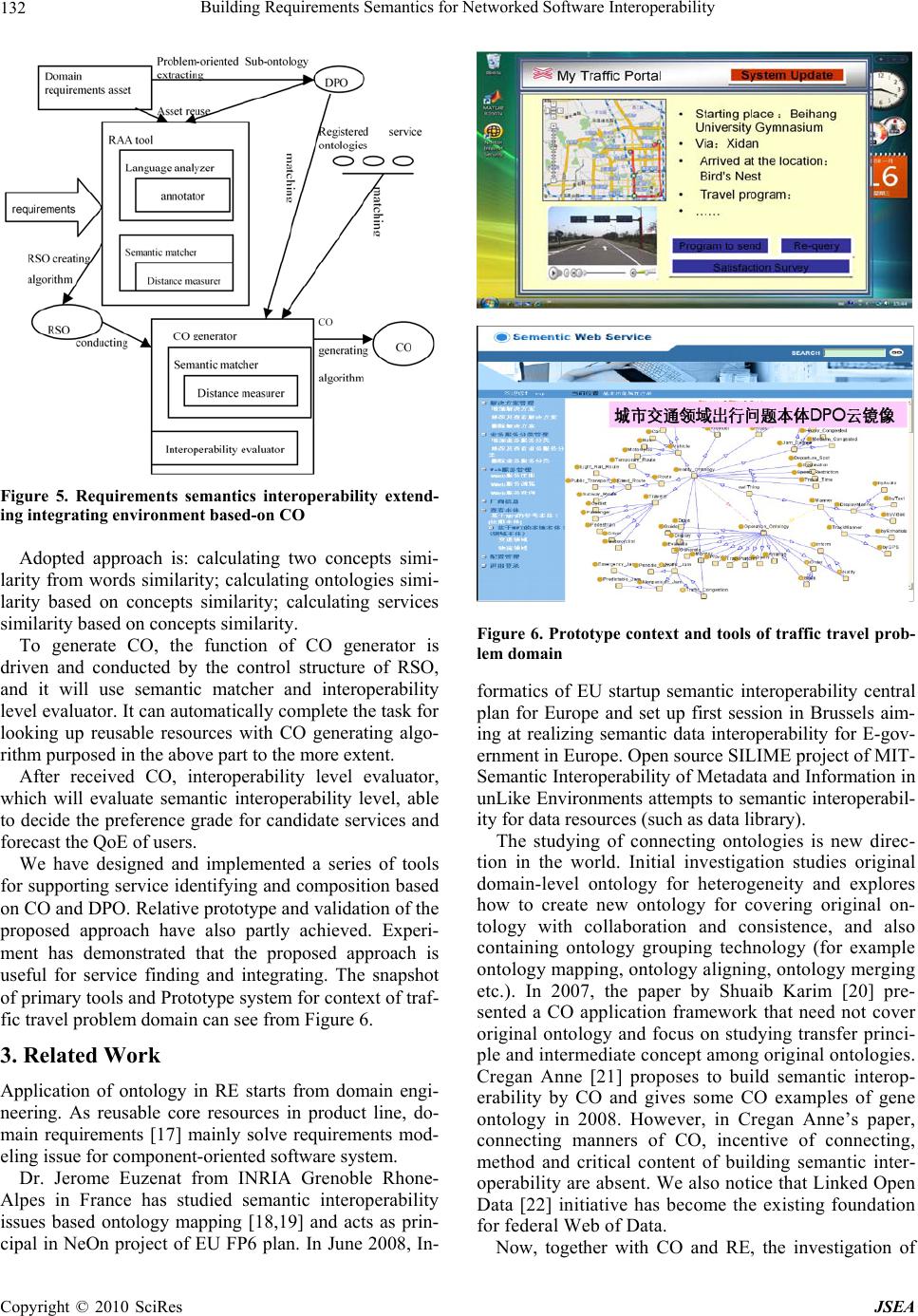 Building Requirements Semantics for Networked Software Inter o perability 132 Figure 5. Requirements semantics interoperability extend- ing integrating environment based-on CO Adopted approach is: calculating two concepts simi- larity from words similarity; calculating ontologies simi- larity based on concepts similarity; calculating services similarity based on concepts similarity. To generate CO, the function of CO generator is driven and conducted by the control structure of RSO, and it will use semantic matcher and interoperability level evaluator. It can automatically co mplete th e task for looking up reusable resources with CO generating algo- rithm purposed in the above part to the more extent. After received CO, interoperability level evaluator, which will evaluate semantic interoperability level, able to decide the preference grade for candidate services and forecast the QoE of users. We have designed and implemented a series of tools for supporting service identifying and composition based on CO and DPO. Relative prototype and validation of the proposed approach have also partly achieved. Experi- ment has demonstrated that the proposed approach is useful for service finding and integrating. The snapshot of primary tools and Prototype system for context of traf- fic travel problem domain can see from Figure 6. 3. Related Work Application of ontology in RE starts from domain engi- neering. As reusable core resources in product line, do- main requirements [17] mainly solve requirements mod- eling issue for component- oriented software system. Dr. Jerome Euzenat from INRIA Grenoble Rhone- Alpes in France has studied semantic interoperability issues based ontology mapping [18,19] and acts as prin- cipal in NeOn project of EU FP6 plan. In June 2008, In- Figure 6. Prototype context and tools of traffic travel prob- lem domain formatics of EU startup semantic interoperability central plan for Europe and set up first session in Brussels aim- ing at realizing semantic data interoperability for E-gov- ernment in Europe. Open source SILIME project of MIT- Semantic Interoperability of Metadata and Information in unLike Environments attempts to semantic interoperabil- ity for data resources (such as data library). The studying of connecting ontologies is new direc- tion in the world. Initial investigation studies original domain-level ontology for heterogeneity and explores how to create new ontology for covering original on- tology with collaboration and consistence, and also containing ontology grouping technology (for example ontology mapping, ontology aligning, ontology merging etc.). In 2007, the paper by Shuaib Karim [20] pre- sented a CO application framework that need not cover original ontology and focus on studying transfer princi- ple and intermediate concept among original ontologies. Cregan Anne [21] proposes to build semantic interop- erability by CO and gives some CO examples of gene ontology in 2008. However, in Cregan Anne’s paper, connecting manners of CO, incentive of connecting, method and critical content of building semantic inter- operability are absent. We also notice that Linked Open Data [22] initiative has become the existing foundation for federal Web of Data. Now, together with CO and RE, the investigation of Copyright © 2010 SciRes JSEA 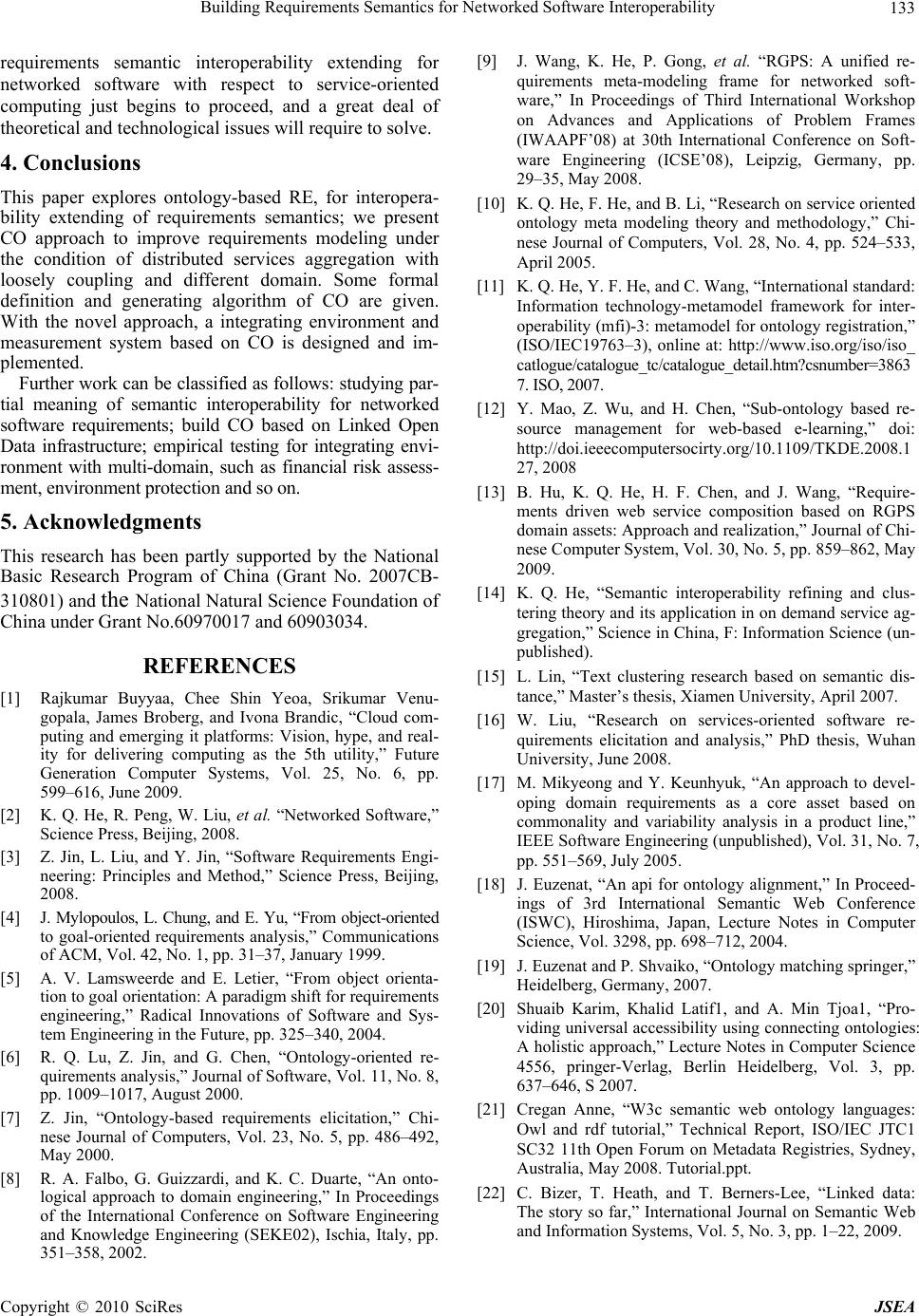 Building Requirements Semantics for Networked Software Inter o perability Copyright © 2010 SciRes JSEA 133 requirements semantic interoperability extending for networked software with respect to service-oriented computing just begins to proceed, and a great deal of theoretical and technological issues will require to solve. 4. Conclusions This paper explores ontology-based RE, for interopera- bility extending of requirements semantics; we present CO approach to improve requirements modeling under the condition of distributed services aggregation with loosely coupling and different domain. Some formal definition and generating algorithm of CO are given. With the novel approach, a integrating environment and measurement system based on CO is designed and im- plemented. Further work can be classified as follows: studying par- tial meaning of semantic interoperability for networked software requirements; build CO based on Linked Open Data infrastructure; empirical testing for integrating envi- ronment with multi-domain, such as financial risk assess- ment, environment protecti on and so on. 5. Acknowledgments This research has been partly supported by the National Basic Research Program of China (Grant No. 2007CB- 310801) and the National Natural Science Foundation of China under Grant No.60970017 and 60903034. REFERENCES [1] Rajkumar Buyyaa, Chee Shin Yeoa, Srikumar Venu- gopala, James Broberg, and Ivona Brandic, “Cloud com- puting and emerging it platforms: Vision, hype, and real- ity for delivering computing as the 5th utility,” Future Generation Computer Systems, Vol. 25, No. 6, pp. 599–616, June 2009. [2] K. Q. He, R. Peng, W. Liu, et al. “Networked Software,” Science Press, Beijing, 2008. [3] Z. Jin, L. Liu, and Y. Jin, “Software Requirements Engi- neering: Principles and Method,” Science Press, Beijing, 2008. [4] J. Mylopoulos, L. Chung, and E. Yu, “From object-oriented to goal-oriented requirements analysis,” Communications of ACM, Vol. 42, No. 1, pp. 31–37, January 1999. [5] A. V. Lamsweerde and E. Letier, “From object orienta- tion to goal orientation: A paradigm shift for requirements engineering,” Radical Innovations of Software and Sys- tem Engineering in the Future, pp. 325–340, 2004. [6] R. Q. Lu, Z. Jin, and G. Chen, “Ontology-oriented re- quirements analysis,” Journal of Software, Vol. 11, No. 8, pp. 1009–1017, August 2000. [7] Z. Jin, “Ontology-based requirements elicitation,” Chi- nese Journal of Computers, Vol. 23, No. 5, pp. 486–492, May 2000. [8] R. A. Falbo, G. Guizzardi, and K. C. Duarte, “An onto- logical approach to domain engineering,” In Proceedings of the International Conference on Software Engineering and Knowledge Engineering (SEKE02), Ischia, Italy, pp. 351–358, 2002. [9] J. Wang, K. He, P. Gong, et al. “RGPS: A unified re- quirements meta-modeling frame for networked soft- ware,” In Proceedings of Third International Workshop on Advances and Applications of Problem Frames (IWAAPF’08) at 30th International Conference on Soft- ware Engineering (ICSE’08), Leipzig, Germany, pp. 29–35, May 2008. [10] K. Q. He, F. He, and B. Li, “Research on service oriented ontology meta modeling theory and methodology,” Chi- nese Journal of Computers, Vol. 28, No. 4, pp. 524–533, April 2005. [11] K. Q. He, Y. F. He, and C. Wang, “In t er na ti onal standard: Information technology-metamodel framework for inter- operability (mfi)-3: metamodel for ontology registration,” (ISO/IEC19763–3), online at: http://www.iso.org/iso/iso_ cat logue/ca talogue_tc/catal ogue_detail.htm?csnumb er=3863 7. ISO, 2007 . [12] Y. Mao, Z. Wu, and H. Chen, “Sub-ontology based re- source management for web-based e-learning,” doi: http://doi.ieeecomputersocirty.org/10.1109/TKDE.2008.1 27, 2008 [13] B. Hu, K. Q. He, H. F. Chen, and J. Wang, “Require- ments driven web service composition based on RGPS domain assets: Approach and realization,” Journal of Chi- nese Computer System, Vol. 30, No. 5, pp. 859–862, May 2009. [14] K. Q. He, “Semantic interoperability refining and clus- tering theory and its application in on demand service ag- gregation,” Science in China, F: Information Science (un- published). [15] L. Lin, “Text clustering research based on semantic dis- tance,” Master’s thesis, Xiamen University, April 2007. [16] W. Liu, “Research on services-oriented software re- quirements elicitation and analysis,” PhD thesis, Wuhan University, June 2008. [17] M. Mikyeong and Y. Keunhyuk, “An approach to devel- oping domain requirements as a core asset based on commonality and variability analysis in a product line,” IEEE Software Engineering (unpublished), Vol. 31, No. 7, pp. 551–569, July 2005. [18] J. Euzenat, “An api for ontology alignment,” In Proceed- ings of 3rd International Semantic Web Conference (ISWC), Hiroshima, Japan, Lecture Notes in Computer Science, Vol. 3298, pp. 698–712, 2004. [19] J. Euzenat and P. Shvaiko, “Ontology matching springer,” Heidelberg, Germany, 2007. [20] Shuaib Karim, Khalid Latif1, and A. Min Tjoa1, “Pro- viding universal accessibility using connecting ontologies: A holistic approach,” Lecture Notes in Computer Science 4556, pringer-Verlag, Berlin Heidelberg, Vol. 3, pp. 637–646, S 2007. [21] Cregan Anne, “W3c semantic web ontology languages: Owl and rdf tutorial,” Technical Report, ISO/IEC JTC1 SC32 11th Open Forum on Metadata Registries, Sydney, Australia, May 2008. Tutorial.ppt. [22] C. Bizer, T. Heath, and T. Berners-Lee, “Linked data: The story so far,” International Journal on Semantic Web and Information Systems, Vol. 5, No. 3, pp. 1–22, 2009. |

